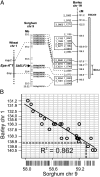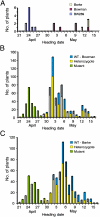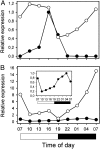Induced mutations in circadian clock regulator Mat-a facilitated short-season adaptation and range extension in cultivated barley
- PMID: 22371569
- PMCID: PMC3306670
- DOI: 10.1073/pnas.1113009109
Induced mutations in circadian clock regulator Mat-a facilitated short-season adaptation and range extension in cultivated barley
Abstract
Time to flowering has an important impact on yield and has been a key trait in the domestication of crop plants and the spread of agriculture. In 1961, the cultivar Mari (mat-a.8) was the very first induced early barley (Hordeum vulgare L.) mutant to be released into commercial production. Mari extended the range of two-row spring barley cultivation as a result of its photoperiod insensitivity. Since its release, Mari or its derivatives have been used extensively across the world to facilitate short-season adaptation and further geographic range extension. By exploiting an extended historical collection of early-flowering mutants of barley, we identified Praematurum-a (Mat-a), the gene responsible for this key adaptive phenotype, as a homolog of the Arabidopsis thaliana circadian clock regulator Early Flowering 3 (Elf3). We characterized 87 induced mat-a mutant lines and identified >20 different mat-a alleles that had clear mutations leading to a defective putative ELF3 protein. Expression analysis of HvElf3 and Gigantea in mutant and wild-type plants demonstrated that mat-a mutations disturb the flowering pathway, leading to the early phenotype. Alleles of Mat-a therefore have important and demonstrated breeding value in barley but probably also in many other day-length-sensitive crop plants, where they may tune adaptation to different geographic regions and climatic conditions, a critical issue in times of global warming.
Conflict of interest statement
The authors declare no conflict of interest.
Figures





References
-
- Amasino R. Seasonal and developmental timing of flowering. Plant J. 2010;61:1001–1013. - PubMed
-
- Kozma-Bognár L, Káldi K. Synchronization of the fungal and the plant circadian clock by light. ChemBioChem. 2008;9:2565–2573. - PubMed
-
- Smith L. Cytology and genetics of barley. Bot Rev. 1951;17:1–355.
-
- Tester M, Langridge P. Breeding technologies to increase crop production in a changing world. Science. 2010;327:818–822. - PubMed
Publication types
MeSH terms
Substances
Associated data
- Actions
- Actions
LinkOut - more resources
Full Text Sources
Molecular Biology Databases

